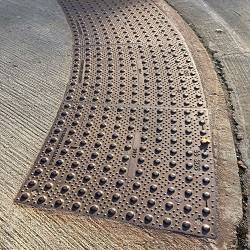









Tactile walking surface indicators, also known as detectable warning surfaces, have come a long way since their inception in the mid-20th century. From humble beginnings as an accessibility solution, tactile products today have transformed accessibility globally and continue advancing. Let's explore the rich history and milestones in the evolution of these indispensable pedestrian cues.
The need for tactile surfaces traces back to post-World War 2 Japan, where nearly half a million military personnel and civilians suffered vision impairment or limb loss. As the nation rebuilt its devastated cities, large numbers of visually impaired veterans faced mobility challenges navigating unfamiliar urban landscapes independently.
In 1965, an engineering student named Seiichi Miyake at Okayama University sought to address this issue. Inspired by reading Braille as a child, he developed the world's first functional tactile paving system - textured concrete cubes with raised bumps resembling Braille dots, detectable underfoot and with a cane.
Miyake's innovative design was chosen for the first tactile installation that very same year near a school for the blind in his hometown of Okayama City. Constructed under his supervision, this pioneering 60-square-metre test site along a busy street crossing kickstarted the tactile paving revolution. Local residents quickly realized its benefits in aiding safe street crossing.
Word of the 'Tenji Blocks' spread across Japan, with early adoptions at pedestrian crossings and transit platforms. Key was the tactile cues' ability to empower independent mobility among growing numbers of vision impaired veterans wishing to participate in post-war reconstruction. Within a decade, tactiles became ubiquitous nationwide and systematically integrated into urban design standards.
Through the 1970s, other Asia-Pacific nations caught on to tactiles' potential in promoting safe, barrier-free mobility. Australia began mandating installations through the Disability Discrimination Act of 1992. The United Kingdom saw compliant tactile deployments through initiatives by the Department for Transport to upgrade infrastructure.
These early adopting countries collaborated closely with Japanese tactile manufacturers, exchanging insights that helped refine designs, standardization, and installation best practices. Established international guidelines promoted intuitive uniformity in cue meanings across divergent cultures and languages.
By the late 1980s, tactiles had permeated streetscapes globally in cities with progressive disability inclusion policies. Notable were expansive tactile rollouts transforming urban landscapes of Bangkok, Hong Kong, Singapore, and Seoul to enhance pedestrian access universally. Intercontinental knowledge transfers laid the groundwork to systematically integrate tactiles into built environments worldwide.
Through the 1970s, tactile products spread internationally, inspired by Japan's success. Australia mandated tactile via the Disability Discrimination Act of 1992, while the Americans with Disabilities Act of 1990 fostered U.S. adoption.
The U.K. Department for Transport led early compliant installations. As standards emerge globally, city infrastructures increasingly incorporate tactiles as mandatory cues at civic spaces like transit hubs, enhancing safety and independence for all.
Initially relying on simple concrete cubes, tactile designs evolved, incorporating new durable materials. Cast iron, stainless steel, and polymer composites delivered slip-resistant textures perfectly mimicking Braille dots.
Profile variations now provided directional bars apart from dome cues while color-contrasting borders aided visibility. Products like ArmorTile offer modular outdoor solutions that are better resilient to freeze-thaw cycles and vandalism.
By the 2000s, tactile design saw intensified standardization through organizations like the International Organization for Standardization (ISO) to harmonize global compliance criteria. Published standards addressed installation best practices and benchmarked material performance traits.
The key was 2015's ISO 23599:2007 standard, which outlined tactile tile properties for slip-resistance, impact durability, weathering, and dimensional stability—essential for ensuring the longevity and safety of installed cues. Products underwent rigorous testing certification before receiving compliant ratings.
Meanwhile, regional codes emerged across Europe, Australia, the Americas, and beyond, mandating tactile use based on precise specifications. In Canada, the AODA legislation of 2005 consolidated national requirements by referencing ISO and CSA standards to promote barrier-free mobility consistently.
Such rigorous oversight globally advanced tactile accessibility – synchronizing expectations for manufacturers, contractors, and facility managers while protecting end-users reliant on detectable surfaces for navigation and hazard avoidance. Overall compliance raised tactile adoption standards industry-wide.
Today's tactiles are intelligent. RFID and QR-coded tiles transmit location data, assisting navigation apps. Select models embed LED lights, aiding low-light mobility.
AI-powered devices recognize tactile layouts, providing audible mapping. Contactless designs even eliminate germ exchange. New materials like 3D-printed stone composites deliver enhanced durability and aesthetics.
Progressive cities worldwide adopted inclusive planning mandating tactiles across the civic infrastructure. Tokyo, London, and Singapore established global benchmarks through coordinated district retrofits that connect amenities to be barrier-free.
Canada's urban centers also progressed in accessibility through collaboration. Today, tactile-compliant infrastructure empowers millions to navigate inclusively and independently, transforming lives.
Nearly most Canadian infrastructure requires tactile indoors per building codes for paths, stairs, and platforms. Core products forming code-compliant options include:
Armor Tile and Access Tile cast paver systems for high-traffic outdoor applications
Advantage Guidance Line single-dome columns ideal for indoor wayfinding
Eon Tile bonded rubber tiles neatly upgrade existing surfaces
Ecoglo nosing indicators and signage aids egress compliance
Our team offers expert guidance on choosing optimal solutions that meet AODA, NBC, and regional municipality standards for indoor/outdoor use, new builds, and renovations.
The world's first tactile paving system was developed in 1965 by Seiichi Miyake in Okayama, Japan.
Major standards and legislations driving tactile adoption include the ADA (1990), AODA (2005), ISO 23599:2007, and the National Building Code of Canada (2015).
Yes, accessibility codes mandate tactiles outdoors at hazards like pedestrian crossings, stair/ramp edges, and hazardous grade changes as per AODA IASR.
Factors include location, existing substrate, traffic levels, aesthetics, and, most importantly - confirmation of code compliance for your regional requirements. Consultation with experts is recommended.
Many tile systems are specifically engineered to smoothly bond to a variety of existing flooring materials, extending their functional lifespan, provided substrate conditions permit.
We hope this covered the rich history, evolution, and key requirements around tactile walking surfaces. Please reach out to Tactile Solution Canada if you have any other queries on enhancing accessibility for your upcoming projects through our code-compliant solutions.
